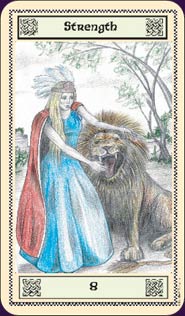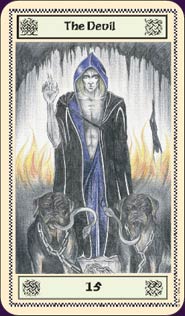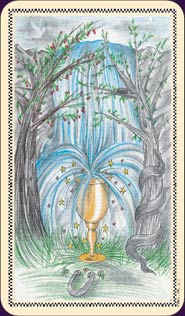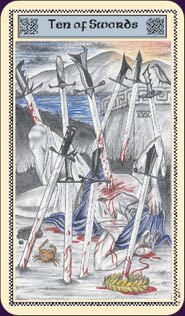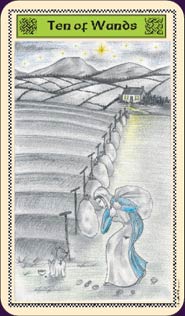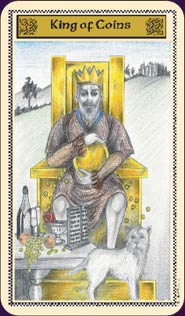Deirdre of the Sorrows Deck Review
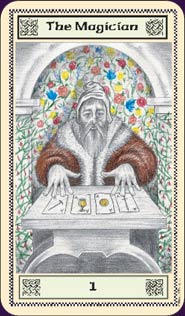
Deirdre of the Sorrows is a 78-card tarot deck designed for the new millennium, and "to lift the Tarot out of the Dark Ages and bring them into the light." The art is delicately illustrated in pencil, with selected touches of colour. Available with a beginners' guide companion book.
Deck Type: Tarot Deck Cards: 78
Creators: Deirdre O'Donoghue
Publisher: Self Published 2007
Retailers
See Price at Tarot UnlockedDeirdre of the Sorrows Review by Davina
To kick off this review, I think it is fair to say I had absolutely no intention of buying another deck for at least 6 months. My collection was large enough and any new deck was likely to be put on a pile with others and never read, only to be traded away in time.
Then somebody on the Aeclectic Tarot Forum posted a message asking if anyone had seen this deck. Curiosity got the better of me, and I had a trawl through the link to the website. The cards looked okay, but they were not calling out to me. I put this deck to the back of my mind, but did read the subsequent postings with interest. It seemed this deck may have been different to many others out there and warranted a second look. The end result? An order was placed, and 3 days later I was a new and proud owner of the Deirdre of the Sorrows tarot.
This was 2 months ago, and in that time, it has been my reading deck of choice. Most people have commented on the cardstock, so let’s get that bit out of the way with. It is wonderful. The linen feel is like no other I have experienced with a deck, and is a delightful change indeed. There is no danger of hearing complaints of glare from the sun or lighting, or the cards being too slippery. They feel incredibly soft, and have a deceptive lightness in weight to them. If anyone is worried that this makes them inferior or less sturdy, believe me that worry is unfounded. I have been feeling and shuffling my copy incessantly and there is barely a mark anywhere to show they have been extensively used. The feel is actually addictive – you will find yourself wanting to just pick them up, hold them, shuffle them or just look at them.
The artwork perfectly matches the cardstock in as much as it is simply drawn and coloured, yet has a richness with regards to the content. Deirdre does draw on the RSW tradition as the basis for the deck but has also shown bravery and insight in making her own mark through her own interpretations of this system. I guess some would call this a RWS ‘clone’ but in my opinion, the move away from the traditional imagery is enough for me to class it as a valid deck in its own right.
Some of the cards are rich in symbolism and imagery whereby the reader will be spoilt for choice when deciding what aspect of the card applies in any given reading. To this extent every reading will be different. There is no standard definition you will find yourself falling back on, and in that respect it surpasses the RWS deck in many ways. Take the first card the Fool for instance. The clever inclusion of other symbols such as the lantern, the key on the chain, the skull and the falling coins will definitely allow your imagination to run wild. If you read intuitively, this deck will be one you will be delighted with time and time again.
One card in particular really does speak on a deeply emotional level. The 5 of cups is one card that is very different to that shown in other decks, yet it speaks volumes. We can almost feel the despair and sense of hopelessness in the character sat at the table. The spider web and wilting plants say so much about the energy and story of the card. I could go on, but there are so many cards in this deck which have this same ability to instinctively tell you which path you should be taking when interpreting it during a reading. What makes this even more incredible is the fact this is not a heavily filled art deck. It is simply drawn and coloured as stated. The artist really did capture the essence of what tarot means to me when he produced this deck.
Deirdre has also created an accompanying book with each card being shown in colour on a full page. This really is an asset. Sometimes some of the symbols are too small to see in the card itself, but by using the book you can identify the symbol with greater clarity. This certainly was the case when I realised from the book, there is in fact a cat cleaning itself on the Page of swords. I have now got two copies of this deck, and cut out the images from one of the books which were then laminated. Whenever I use the cards, this laminated set is also used alongside. The text is aimed at beginners, but I would say any reader, regardless of level of experience will find it useful at times. If only for the “well, I would not have thought of that!” scenario. The style makes for easy reading, yet without patronising the reader.
So, to finish with who would I recommend this deck to? Anyone who enjoys reading intuitively. Also to anyone who likes the earthly rustic feel to his or her deck. Believe me, after a period of time it will be possible to view this deck as being akin to a comfortable pair of slippers. You will not want to be without it.
Deirdre of the Sorrows Review by Mary K. Greer
Deirdre -
They are probably the best shuffling deck I've ever shuffled! The card stock and linen finish go great with the medium used, although I find that the dominance of pencil gives an overall grayishness to the cards that is not as bright and happy as I like. But this is not serious and serves to create a different look that's valuable in its own right.
I like the fact that you felt free to redefine the scenes. A few I'll have to get used to, but all are intriguing and don't put me off as so many new approaches do. I feel like they will make sense, and expand my understanding of the tarot as I get to know them. It is a rare thing for me in modern tarot - a truly usable deck!
Congratulations on a job well-done. I think this deck deserves to get recognized as a valuable contribution to a tarot-reader's working stock.
Mary K. Greer
Deirdre of the Sorrows Review by Richard de Meath
Once in a while I like to purchase several new and different packs of Tarot Cards. This was the case recently, when I came across the 'Deirdre of The Sorrows' tarot deck. I found my long search for a suitable Tarot Deck for a new millennium were immediately answered. Of course I could easily design my own deck, but with so many excellent ones to choose from, why bother?
With 50 years of Tarotical experience, it gives me pleasure to teach the Tarot to both beginners and advanced students. All too often some of the students would puzzle over the imagery contained within each card. There are those inevitable moments, when no matter what pains I take to reveal the hidden meanings, this knowledge passes over their heads. No teacher likes to admit defeat, often blaming the student for this failure. However, with my discovery of the Deirdre of The Sorrows Tarot Deck, I have since found that students were immediately drawn to the subtle imagery and clarity contained within each card.
Deirdre O'Donoghue uses easy-to-understand language in the accompanying book. I made no apologies to my friends and students alike when I urged them to read it before dipping into the cards themselves. There is a useful guide to meditation, which I often recommend as well. I cannot think of another book which offers such advice. Right from the first page, I was enchanted by the her use of language. designed to appeal to all levels, at no point could I find fault with her descriptions of advice. I could almost imagine Deirdre standing behind me, her encouraging voice speaking softly into my ear, as I sat reading.
No teacher should narrow his or her vision when dealing with the various aspects contained within the Tarot. Whatever it is that one searches from within the Major and Lesser Arcana, truth is to be found. Indeed it is almost churlish for one to do so and as much as I hate to pick one card from the 78 for special mention, I somehow feel The Tower deserves special mention. With the obvious image of the Twin Towers in the background for guidance, the student is made aware of the enormous importance this holds in any Spread. Gone is the Rider Waite image of a Castle Tower destroyed by lightening, replaced by the splendour of the bold Eagle, long associated with Nobility and Rule. The illustration reveals the Eagle awakened and immediately on guard and protective. Behind the Eagle is revealed the emerging Sun, its light emerging from the destructive forces. the announcement of a fresh beginning, new hope and the departure from failure and it attendant fears.
I bought ten packs and have given most of them to friends and students alike. Very soon I shall have to replenish my stock and order ten more sets.
Deirdre of the Sorrows Review by Kate Hill
Tarot Unlocked is a Tarot set with a beginner level tarot book, and Deirdre of the Sorrows, a modern, Irish Tarot deck and book set. Together, they are designed to make it easier or new tarot users to understand the cards and their meanings, and still have a little more depth for those who want it.
The detailed, mostly black and white cards have a natural and close-to-the-earth feel about them. Many show farming or pastoral scenes or take place outside, in the fields, while other scenes take place in ordinary urban life, still others in the medieval fantasy world so common to tarot cards. The Wands have agricultural scenes; Cups are domestic scenes; Pentacles scenes of money and daily work; and Swords scenes of problems and concern.
Unlike decks where the tarot artist takes liberties with the symbology and produces more of a pretty than precise image, in Deirdre of the Sorrows each symbol has been carefully chosen. According to designer and professional Tarot reader Deirdre O’Donaghue, each card “contains many elements which the inexperienced eye will not notice. These aspects become clear at the intermediate and senior stages of learning”. While not her own artistic creation, the illustrator, Wayne McGuire, worked closely with Deirdre and drew the cards to her exacting requirements.
The imagery has Rider-Waite foundations; but simplified, a little altered to fit the theme, and a little prettified for beginners make the scenes unique to this deck. The Six of Coins shows a homeless person begging outside a pawn shop. The Ace of Swords shows Alexander the Great holding a sword, poised to cut the Gordian knot. The Devil is more alien than satanic, and holds two pit pulls on chains rather than people. Death is rather fearsome – he wears a colourful war mask, a necklace of skulls, and, of course, holds a very sharp scythe. The Six of Wands is a modern rendition: a jockey speeds down the straight in a horse race, looking over his shoulder as he cruises to victory.
There is lots of scope in these cards for intuitive readings and for building stories from the expressive and lifelike scenes. The body language is expressive, poses and body positions intentional, objects and their location all intentionally placed. The perspective in a drawing or two is a little shaky, but on the whole they are thoughtfully drawn and effectively convey the card’s message. The highlights of colour also provide emphasis to elements of the otherwise black and white scenes.
In the hand, the cards have a very textured feel, with small horizontal and vertical ridges on the cardstock. They are non-laminated and uncoated.
The 176-page book, Tarot Unlocked, is the beginner text for the Deirdre of Sorrows deck, designed to make it easier for new tarot users to understand the cards and their basic meanings. It doesn’t comment on more complex symbology or associations, though these are in the cards (future books will talk about these, and the use of reversed cards).
It begins by introducing tarot at a very basic level, following with techniques to aid concentration and prepare for a reading, and advice on how to conduct a reading. After these ten pages are the card meanings, which begin (unusually but aptly) with the Ace of Wands. These are accompanied by card illustrations that are markedly bigger than the actual cards – a nice help when you’re scrutinising the symbolism described in the text. Each card has an explanation of the scene, how to interpret the card in a reading, plus four ‘keys’ or key words.
At the very back of the book is a little graduation test – images of the three cards. If you can interpret them without referring to the text, you pass. I like this test; it’s very simple but very effective way of knowing if you’ve been learning or just skimming the content.
Deirdre of the Sorrows reminds me a little of an Irish version of the Far Sight Tarot. It has fresh art and a unique theme, and thoughtful changes to the traditional symbolism that personalise the tarot scenes and give them a sense of place. While the set is designed and suitable for beginners, the deck has enough depth to also be of interest to more experienced readers.
Deirdre of the Sorrows Review by Lisa Silver Crow Perreault
This is a wonderful deck illustrated in pencil, the shades of gray bring out the colors of each card brilliantly. The more I read with this deck, the more color seems to jump out from each card. The linen card stock seems to enhance the artwork in a way you don’t normally see in tarot decks. The cards have a soft, pliable feel, shuffle very well, and despite their softness they are sturdy and will hold up well. The backs are a matt black with a golden Celtic cross in the center which is reversible.
The imagery in this deck compliments the RWS tradition, but there are unique changes with a more global outlook that enhance the beauty and meaning behind this deck. The down to earth feel is realistic but yet dreamy. Each card is a place you would want to visit and spend time in and each reading will bring about a different view of the card. The bits of color really allow you to see the cards differently and from a unique perspective which will change depending on the type of reading you are doing.
The pastoral theme in marriage with a by gone era is as relevant today as any. I would recommend this deck for beginners as well as the seasoned reader. The book that accompanies this deck will allow the new tarot reader an easy to follow introduction to the tarot, which gives basic meanings in a wonderfully structured text that allows for further interpretation when the reader is ready to move on. There is also a wonderful free e-book available on the artist’s web-site that will allow the reader to further their understanding of the symbolism in this warm and easy to read deck.
This is a deck that will remain a favorite of mine for many years to come. I highly recommend it for it’s ease of reading as well as it’s depth of symbolism, both outward and hidden. This deck deserves to been not just seen and enjoyed for the artwork, but for its wonderful messages for the world we live in today. This is also a deck that can be used to read for children or those that are sensitive to nudity or violence.
Deirdre of the Sorrows Review by Kathleen Meadows
Deirdre of the Sorrows tarot is named after a tragedy play written by Irish playwright John Millington Synge, first performed at the Abbey Theatre by the Irish National Theatre Society in 1910. The play is based on Irish Mythology, in particular the myths concerning Deirdre and Conchobar. Deirdre, in naming her deck after this Irish myth is linking her name and heritage to the naming of her deck. The problem is that it may be too subtle a title for perspective customers to connect to this deck. Although it directs us to consider the book and deck set Irish, possibly Celtic, the images on the cards are not especially either. The back of the deck is most assuredly Celtic, featuring a gold knot on a black background but really in terms of imagery, that's the beginning and end of an especially Irish or Celtic association. Alternatively I might have titled it, 'A Simple Tarot from Ireland'.
Deirdre describes her process in doing this deck as a way to help new tarot readers with the Tarot, "I've been studying Tarot for many years and I have often heard the comment that the cards are too difficult to learn. I decided to write a beginners guide, describing the basics of each card, to assist and ease the learning process. To make learning even easier I designed a new deck of cards, 'Deirdre of the Sorrows'." On her web site she is offering a free, downloadable ebook describing in more detail the symbolism she used in the cards. This is a Tarotist serious about creating a work to help, in every way possible, new Tarotists learn to do a good tarot reading. Her goal to create a Tarot easy for the beginner Tarotist to learn was perfectly met. As an experienced Tarotist and teacher of the Tarot, I love this body of work.
When I first discovered this set, I was immediately curious and excited because so few tarot books and decks come out of Ireland. I found myself anxiously waiting for the deck to arrive and when it did I raced off to my office, opened up the package, glanced quickly through the book, and reached for the deck. Like most people I was immediately struck by the feel of it. It has a smooth finish feeling more like stiff linen than cardboard. But that's no reason to buy a tarot deck! You aren't likely to choose to work with a tarot deck just because it feels nice in your hands. I think most people buy tarot decks because they love the imagery and the accompanying text that explains the rationale behind the imagery.
The drawings are detailed and must have taken the artist, Wayne McGuire, a considerable investment of time to complete. What surprised me was that when I shared it with my tarot students, few were as excited and as impressed as I. Their lukewarm reaction made me question my own initial enthusiasm. I really didn''t want to write a review that sounded apologetic or defensive.
I use Deirdre of the Sorrows often, finding the images detailed, expressive and rich with story. The structure and imagery is based on the style initiated by Pamela Smith for the Waite deck. The settings, the expressions on the faces of the characters, the way colour has been used and omitted are delightfully original.
Like all decks and most people, I have my favourite cards. A few of my favourites are the Five of Wands, the 10 of Coins, the Two of Coins and the Ace of Wands. Notice that I identified pip cards. They are among the best artistic renditions of the pip cards that I have ever seen. For the new reader, this deck would be a relief and joy to use because it is typically the pip cards that cause the new reader the most anxiety. There are so many of them to learn and feel confident interpreting. To be able to see the story of the card laid out before you is a treat.
Deirdre's accompanying book to the deck, Tarot Unlocked, is also enormously helpful. On the right-hand side of each open page is a full page featuring a full colour picture of the card and on the left-hand page is a full description of the card and how to interpret this card in a reading. You can study this book anywhere without having to bring your cards with you. This book is like going to see a reader that does a layout and discusses the tarot reading in very plain terms that every client can understand, relate to, and apply to their lives. For example, Deirdre describes the Six of Coins:
"You will not be surprised to learn that the title of this card is the charity card. This does not mean you give your money away but you must behave in a charitable way by word and deed. The scales are a reminder that when you find your balance, harmony will return, and remember that balance plus harmony equals success. It looks like you will be receiving money from a third party."
Looking at the Six of Coins, it really is
obvious this is what how the card should be interpreted.
Obviously I recommend this deck. It's beautiful to hold and
behold. Its power is in its simplicity and honour.
Congratulations to Deirdre for creating such a great set. As a
teaching tool it is unmatched but that in no way detracts
from its joy to work with, even for such a
crone-tarotist like myself.
Complete Details of Deirdre of the Sorrows
Creators: Deirdre O'DonoghuePublisher: Self Published 2007
Deck Type: Tarot Deck
Cards: 78
Major Arcana: 22
Minor Arcana: 56
Deck Tradition: Rider-Waite-Smith
Minor Arcana Style: Unique Scenes Without Suit Symbols
Suits: Cups, Swords, Wands, Coins
The Fool is 0
Strength is 8
Justice is 11
Card Size: 2.76 x 4.72 in. = 7.00cm x 12.00cm
Card Language: English
Card Back: Reversible
Back Design: Black with a yellow Celtic knotwork design in the centre
Rating: 16/20 or
Similar Decks to Deirdre of the Sorrows
< Previous Deck · Back to Top · Next Deck >
Home > Tarot Reviews > Deirdre of the Sorrows Review

